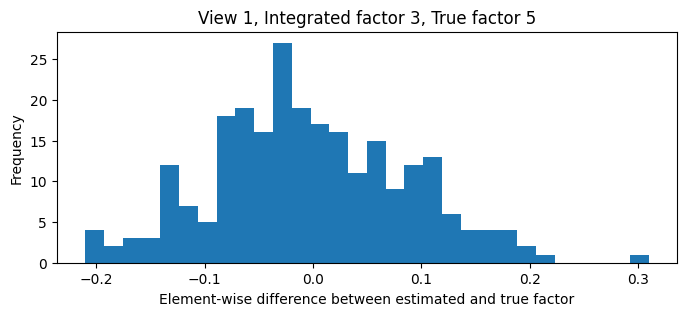This is a package implementing the data integration methodology described in "Large-scale Data Integration using Matrix Denoising and Geometric Factor Matching" (Held, 2024, arXiv:2405.10036 [stat.ME]).
To install the package run
pip install git+https://github.com/cyianor/lscmf.gitA simple usage example is shown below:
import lscmf
from numpy.random import default_rng
# Control randomness
rng = default_rng(42)
# Simulate some data
# - `viewdims`: Dimensions of each view
# - `factor_scales`: The strength/singular value of each factor.
# The diagonal of the D matrices in the paper.
# - `snr`: Signal-to-noise ratio of the noise added to each true signal
#
# The function below generates orthogonal matrices V_i and uses the
# supplied D_ij to form signal matrices V_i D_ij V_j^T. Noise with
# residual variance controlled by the signal-to-noise ratio is added.
xs_sim = lscmf.simulate(
viewdims={0: 500, 1: 250, 2: 250},
factor_scales={
(0, 1): [3.0, 2.5, 2.0, 0.0, 0.0],
(0, 2): [2.8, 0.0, 0.0, 2.0, 0.0],
(1, 2): [1.2, 0.0, 5.0, 0.0, 1.1],
},
snr=1.0,
rng=rng,
)
# `xs_sim` is a dictionary containing
# - "xs_truth", the true signal matrices
# - "xs", the noisy data
# - "vs", the simulated orthogonal factors
# Create the lscmf object and fit the model to data
est = lscmf.LargeScaleCMF().fit(xs_sim["xs"])Estimates of model parameters are then contained in the LargeScaleCMF object.
The estimated singular values can be accessed as shown below.
est.ds_{(0,
1): array([ 2.98687823, 0. , -1.96015864, 0. , 2.47498787]),
(0,
2): array([-2.78861131, 1.96604697, 0. , 0. , 0. ]),
(1,
2): array([-1.13272996, 0. , 4.98917765, -1.00988163, 0. ])}
The estimated factors can be accessed as follows, e.g., for view 0 the first factor is
import matplotlib.pyplot as plt
cos_angle = (est.vs_[1][:, 2] * xs_sim["vs"][1][:, 4]).sum()
print(f"Scalar product between estimated and true factor: {cos_angle:.2f}")
fig = plt.figure(figsize=(8, 3), dpi=100)
ax = fig.add_subplot(111)
# Negate integrated factor since it was estimated as -v instead of v
ax.hist((-est.vs_[1][:, 2]) - xs_sim["vs"][1][:, 4], bins=30)
ax.set_xlabel("Element-wise difference between estimated and true factor")
ax.set_ylabel("Frequency");
ax.set_title("View 1, Integrated factor 3, True factor 5");Scalar product between estimated and true factor: 0.00
A raw graph-based interface exists as well.
# Create a view graph to hold the data layout
G = lscmf.ViewGraph()
# Add data
# - `names` need to be provided as an iterable.
# These are in general arbitrary, however, in case of
# repeated layers, each layer requires a unique name.
# - `xs` is an iterable to the input data in the same order as
# `names`
# - `viewrels` is an iterable containing tuples describing the
# relationships between views contained in data matrices.
G.add_data_from(["x01", "x02", "x12"], xs_sim["xs"].values(), [(0, 1), (0, 2), (1, 2)])
# Once data is added to the view graph, joint matrices for each
# view need to be formed and denoising needs to be performed.
# Different types of shrinkers can be used for denoising and they
# depend on the type of loss assumed for reconstruction of the
# signal. See Gavish and Donoho (2017) for details.
# In the paper, Frobenius loss is assumed, and therefore the resulting
# `FrobeniusShrinker` is used here.
lscmf.precompute(G, lscmf.FrobeniusShrinker)
# Finally, matching of factors for each view and merging of the
# factor match graphs is performed. This function returns
# the final merged factor match graph.
H = lscmf.match_factors(G)Matches in the factor match graph can be investigated. MatchNodes contain a data_edge, which is a MultiEdge(name, viewrel) corresponding to an input matrix during view graph construction, and a factor which is the factor in the data_edge. Keys of the dictionary are integrated factors.
In the example below, MatchNode(data_edge=MultiEdge(x01, (0, 1)), factor=0) is the first factor in data matrix
The numbering of integrated factors is arbitrary and may be non-consecutive.
H.graphdefaultdict(set,
{0: {MatchNode(data_edge=MultiEdge(x01, (0, 1)), factor=0),
MatchNode(data_edge=MultiEdge(x02, (0, 2)), factor=0),
MatchNode(data_edge=MultiEdge(x12, (1, 2)), factor=1)},
2: {MatchNode(data_edge=MultiEdge(x02, (0, 2)), factor=1)},
1: {MatchNode(data_edge=MultiEdge(x01, (0, 1)), factor=2),
MatchNode(data_edge=MultiEdge(x12, (1, 2)), factor=0)},
3: {MatchNode(data_edge=MultiEdge(x12, (1, 2)), factor=2)},
4: {MatchNode(data_edge=MultiEdge(x01, (0, 1)), factor=1)}})
Reconstruction of LargeScaleCMF.fit() and it is recommended to use that interface unless the graph interface is required for a specific reason.
